Infection Control Manual: Overview
Purposes
- To improve hand hygiene practices among nurses and to foster infection control in the setting.
- To comply with National Patient Safety Goals.
Indications for hand hygiene
The nurse should wash hands/apply alcohol-based sanitizers. . .
- When arrived at work,
- If hands are visibly contaminated,
- Before donning/after taking off gloves,
- Before and after contact with a patient, and so on.
The setting selected for the present evidence-based research project utilizes a comprehensive infection control manual to promote and maintain hand hygiene among nurses. The major purposes of the given document are to improve patient safety within the hospital and to ensure that all staff members comply with the national standards of professional conduct and national healthcare goals.
The organizational policy indicates precisely in which situations hand washing and other hygiene procedures such as alcohol-based hand rubs should be practiced to prevent the spread of nosocomial infections (NIs) in pediatric patients. For instance, it suggests practitioners wash hands/apply hand antiseptic agents before performing invasive procedures, before and after touching inanimate sources of contamination, between contacts with different patients and so on. The document comprises exact indications for hand hygiene practice: it states in which cases hand washing and hand antisepsis is imperative. For instance, decontamination of hands is required after each contact with a patient and equipment, after removing gloves, after visible contamination of hands, before eating, and so on.

Hand Hygiene Procedures and Practices
- Purpose:
- To physically remove transient microbial contamination acquired from contacts with patients and hospital environment.
- Procedures:
- Equipment cleansing,
- Handwashing,
- Utilization of alcohol-based hand rubs,
- Skin care.
The document also contains a list of basic hand hygiene procedures aimed to remove different types of contamination. The given section is divided into four major parts: equipment, hand washing/hand hygiene policy (with procedural steps and rationale), skin care, and other aspects of hand hygiene. For instance, the policy/manual prohibits wearing artificial nails at the medical site and recommends nurses keep their nail tips about 1/4 inch long. Additionally, the policy includes other evidence from professional guidelines and standards by the CDC, WHO, and APIC.
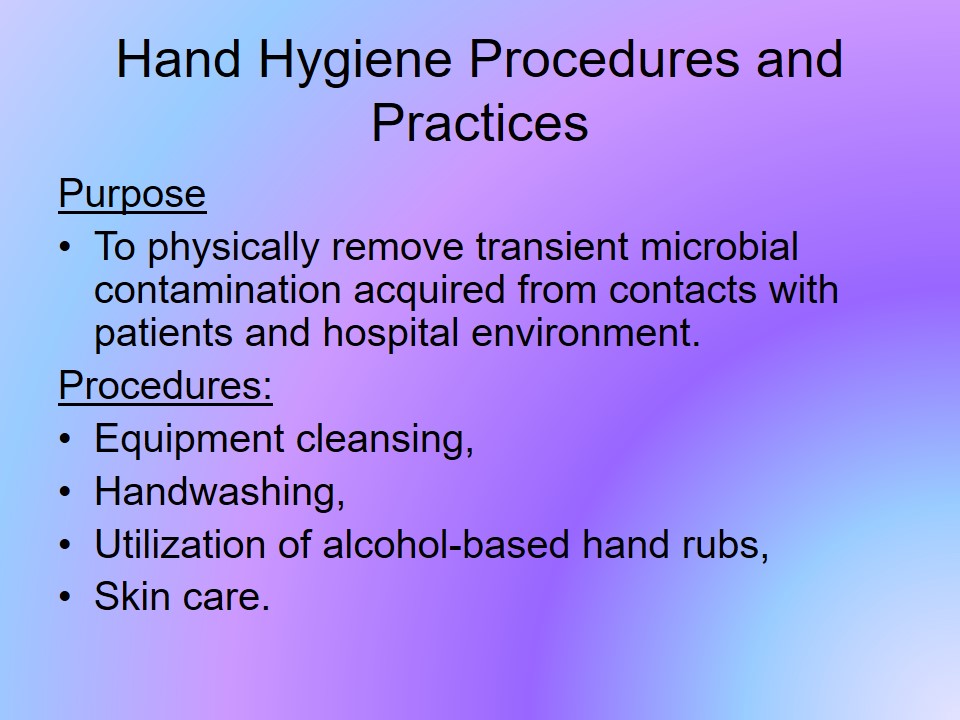
Evidence Search Methods
- Utilized databases:
- PubMed,
- Google Scholar,
- EBSCO Host.
- Keywords:
- Hand hygiene procedures,
- Nurse handwashing practices,
- Clinical hand hygiene protocols.
The analysis of the current organizational hand hygiene policy and procedures is conducted based on recent research evidence and data collected from credible resources. To locate the high-quality evidence, such databases as PubMed, Google Scholar, and EBSCO Host were utilized. The preference was given to systematic reviews and professional guidelines because they provide the highest-quality evidence, which is filtered, pre-appraised, and exclusive of substantial biases. The keywords used during the search include hand hygiene practices, handwashing procedures, clinical hand hygiene protocol.
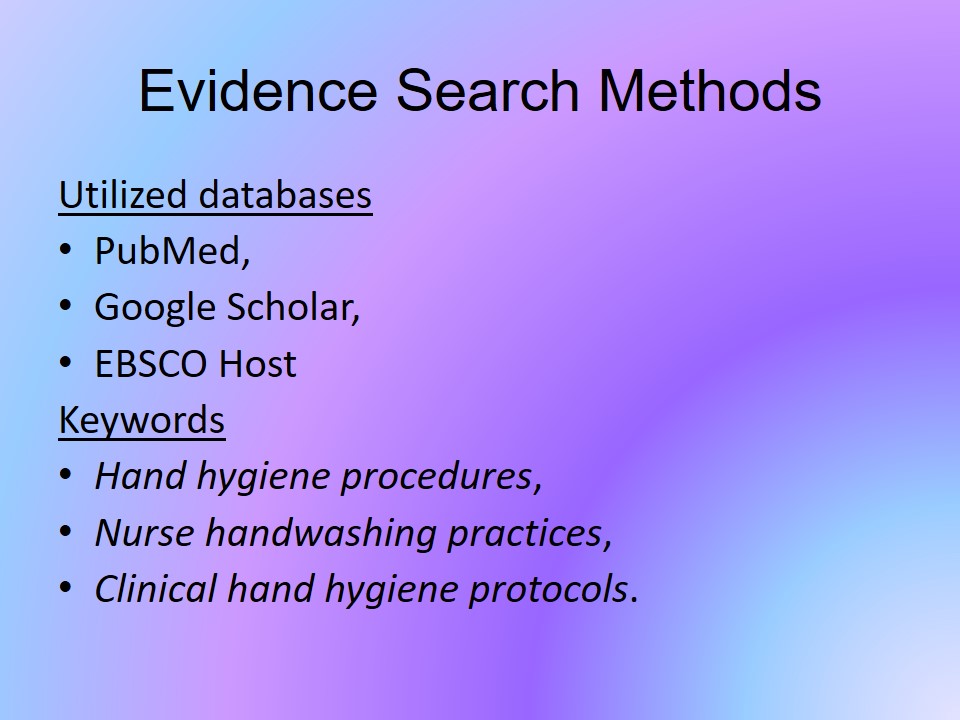
Evidence Review: Outline
- Rationale for Using Evidence-Based Hygiene Practices;
- Materials and Preparation;
- Water and Soaps;
- Alcohol-Based Sanitizers;
- Gloves.
- Equipment Sterilization;
- Hand-Drying Methods;
- Monitoring and Audit Methods.
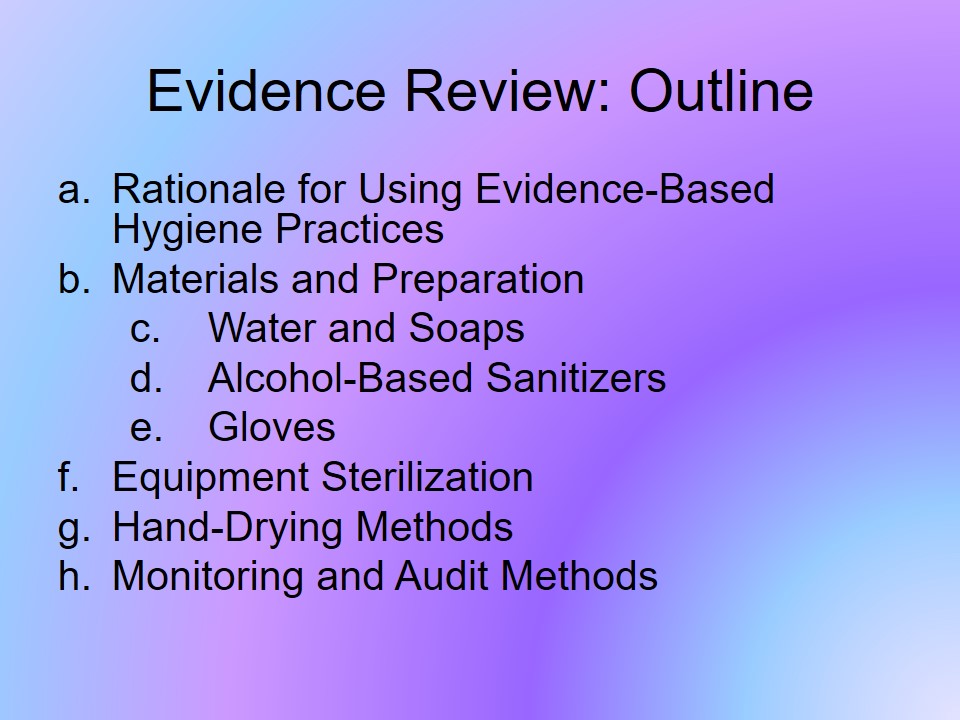
Rationale for Using Evidence-Based Hygiene Practices
- Nurses can transmit bacteria from out-of-hospital sources.
- Most of the nurses prefer to conduct a self-analysis of possible infection risks rather than regularly comply with established behavioral standards.
- Self-analysis regarding hand hygiene can be inherently biased and associated with increased risks of HAI exposure.
- Strict adherence to hand hygiene protocols at the hospital wide-level is one of the most effective ways to prevent HAIs.
Researchers and healthcare organizations agree that the adherence to hand hygiene regimes at the hospital wide-level is one of the most effective ways to prevent NIs. As stated by CDC (2002), “health-care-associated pathogens can be recovered not only from infected or draining wounds, but also from frequently colonized areas of normal, intact patient skin” (p. 4). Moreover, WHO (2009) states that nurses can transmit bacteria from out-of-hospital sources through such objects as cream jars, artificial fingernails, and so on. At the same time, Winship and McClunie-Trust (2016) claim that the majority of nurses usually conduct a self-analysis of possible infection risks before administering hygiene practices rather than complying with established behavioral standards. For example, they may use protective equipment merely when dealing with body fluids and visible contamination, while ignoring hand hygiene procedures in all other cases. The evidence related to the transmission of pathogens provided by CDC (2002) and WHO (2009) indicates that nurses’ self-analysis regarding hand hygiene can be inherently biased and associated with increased risks of NIs exposure.
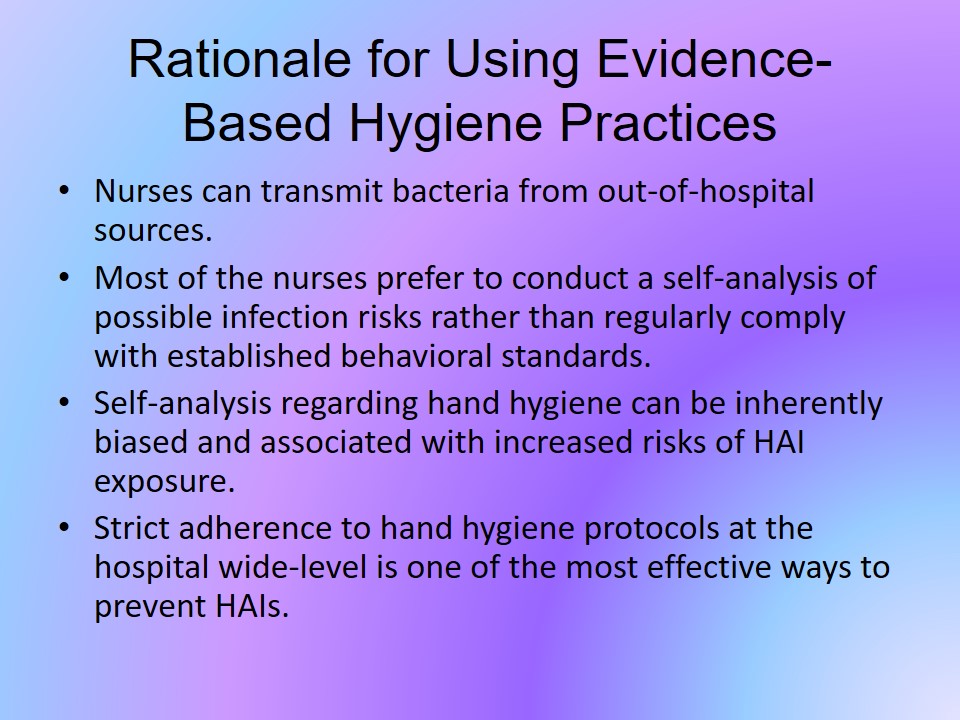
Materials and Preparations
Water and Soaps
- High-quality water is a fundamental element of hand hygiene.
- If there is a risk of water source contamination in the hospital, it should be treated with UV irradiation, chlorine dioxide, etc.
- Soaps remove loosely adherent microorganisms.
- The recommended duration of handwashing with soap is 30 seconds.
According to WHO (2009), in order to maintain a high level of patient safety on the site, hospitals should provide staff members with high-quality water, hand drying materials such as disposable towels, plain soap, and alcohol-based hand antiseptics. Water is a fundamental element of hand hygiene as it serves to remove dirt and other organic materials, yet it is observed that “tap water in health-care institutions can be a source of nosocomial infections” (WHO, 2009, p. 30). Thus, if it is suspected that the water in the setting is contaminated, it must be filtered or disinfected by using UV irradiation, chlorine dioxide, and other agents. As for plain soaps, they can effectively remove loosely adherent bacteria. As stated by CDC (2002), “handwashing with plain soap and water for 15 seconds reduces bacterial counts on the skin by 0.6–1.1 log10, whereas washing for 30 seconds reduces counts by 1.8–2.8 log10” (p. 8).
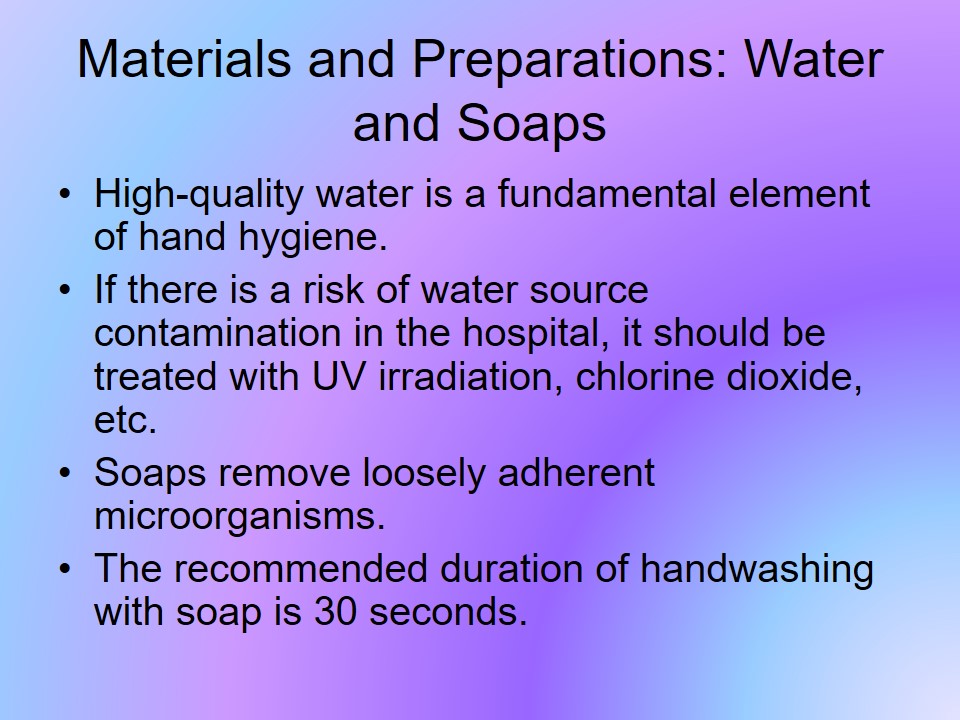
Alcohol-Based Sanitizers
- Alcohols can significantly reduce the counts of transient flora on the hands.
- The use of alcohol-based hand rubs is especially important when nurses have limited time and access to water sources.
- The regular utilization of alcohol-based agents can lead to skin irritation.
- Hand lotions can help minimize the adverse effects of alcohols on the skin.
Along with this, alcohols can significantly reduce the counts of transient flora on the hands. For instance, they proved to have an “excellent in vitro germicidal activity against gram-positive and gram-negative vegetative bacteria, including multidrug-resistant pathogens (e.g., MRSA and VRE), Mycobacterium tuberculosis, and various fungi” (CDC, 2002, p. 8). For this reason, Winship and McClunie-Trust (2016) recommend hospitals to provide enough of alcohol-based hand rubs for nurses especially in the context of high workloads when they do not have time to use traditional soap and water frequently. Although alcohol-based sanitizers are considered to be relatively safe agents, their regular use can lead to skin irritation. Therefore, WHO suggests using hand lotions and creams as they “contain humectants, fats, and oils that increase skin hydration and replace altered or depleted skin lipids that contribute to the barrier function of the skin” (p. 63).
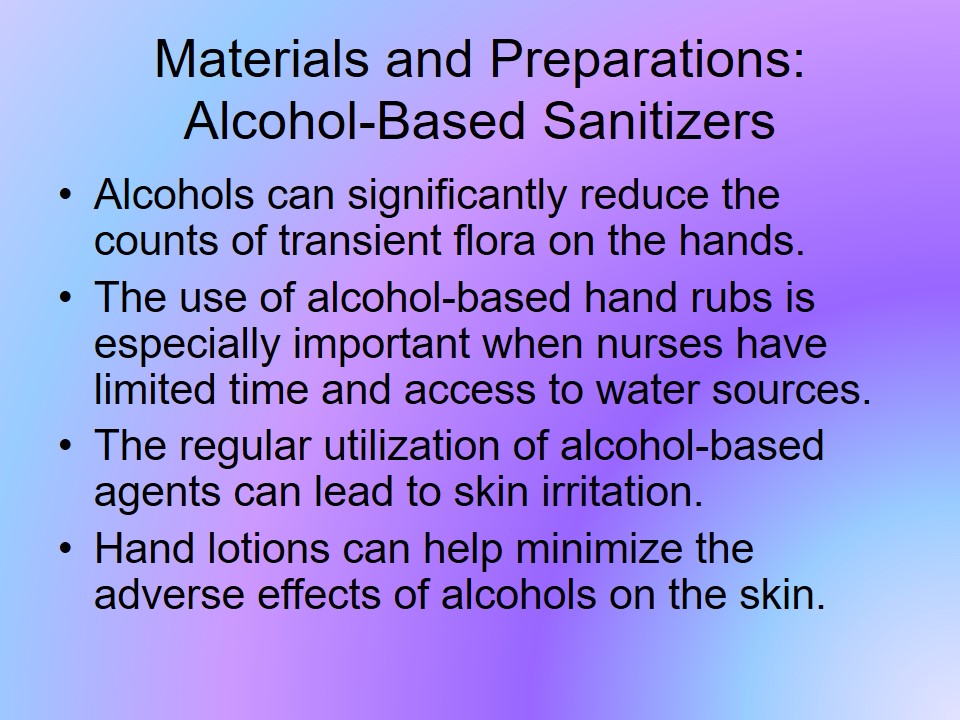
Gloves
- Protective gloves can halve the risk of hand contamination during the contact with body fluids.
- It is recommended to wash hands after taking the gloves on/off.
- Gloves should be changed before contact with a new patient.
- Like alcohols, gloves may induce skin irritation which can be intervened by using moisturizers.
Additionally, since hand contamination is almost inevitable during patient care, it is essential to wear protective gloves even during the contacts intact skin areas. According to WHO (2009), gloves can halve the risk of hand contamination during the contact with body fluids. However, as they cannot fully protect nurses from infection, it is recommended to change gloves frequently and wash hands before and after taking the gloves on/off. It is worth mentioning that as in the case of alcohol-based agents, wearing of gloves can cause skin irritation, which is regarded as one of the factors leading to non-compliance with hygiene protocols and standards (WHO, 2009). The application of moisturizer on hands before wearing of gloves can help nurses preserve skin integrity and eliminate the risk of non-adherence.
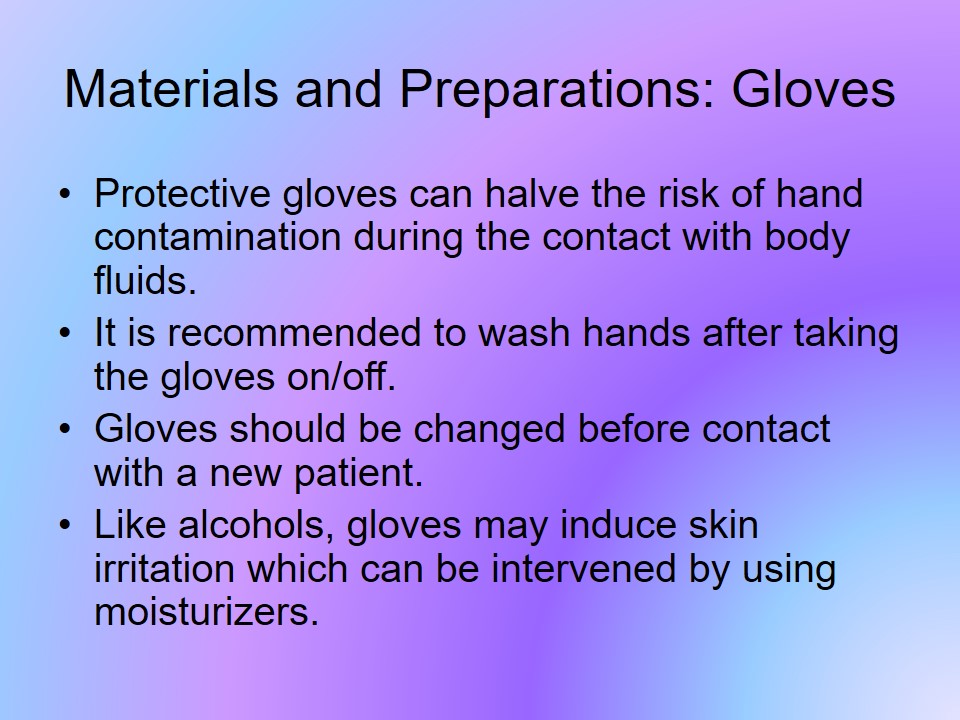
Equipment Sterilization
- Medical equipment is associated with a major risk of nurse-to-patient transmission of bacteria.
- High-level sterilization is essential for critical/semi-critical medical devices.
- Utilization of intermediate and low-level disinfectants is recommended for the cleansing of hospital environments and noncritical clinical devices.
Medical equipment and devices including waste receptacles are associated with a major risk of nurse-to-patient and patient-to-patient transmission of bacteria. Regular administration of high-level sterilization is essential for critical/semi-critical medical devices (i.e., devices introduced into the patient’s bloodstream/comes in contact with the patient’s mucous membranes), depending on the medical procedure. According to CDC (2001), high-level sterilization and disinfection of all equipment units by using chemical sterilants, as well as heat pasteurization, can kill multiple types of viruses and bacteria. Still, it may not be able to eliminate bacterial spores entirely. At the same time, the utilization of such intermediate and low-level disinfectants as detergent germicides and a 1:100 solution of bleach is recommended for the cleansing of hospital environments and noncritical clinical devices (CDC, 2001).
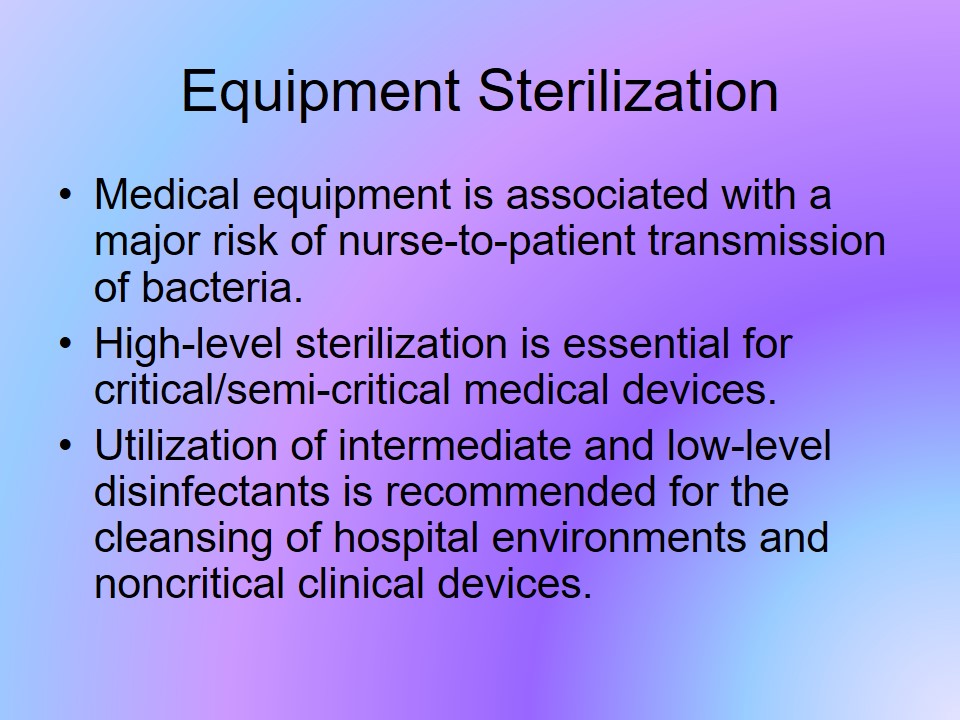
Hand Drying Methods
- Wet skin is associated with higher risk of bacteria transmission: drying of hands after washing is core to organizational hand hygiene.
- Hand drying with paper towels is more efficient than with hot air dryers.
- Paper towels are associated with better physical removal of bacteria.
- Hot air dryers increase the risk of airborne dissemination of pathogens.
According to Huang, Ma, and Stack (2012), “the transmission of bacteria is more likely to occur from wet skin than from dry skin; therefore, the proper drying of hands after washing should be an integral part of the hand hygiene process in health care” (p. 791). Paper towels and hot air dryers are the two most commonly used types of hand drying methods across hospitals. They are associated with different levels of drying efficiency: the mean hand-drying time for using paper towels is 10 seconds, while hot air dryers require about 20 seconds to remove moisture (Huang et al., 2012). Additionally, Huang et al. (2012) observe that paper towels are associated with better physical removal of bacteria and prevent airborne dissemination of pathogens. Thus, towels should be a preferable material used in the organizational hand hygiene practices.
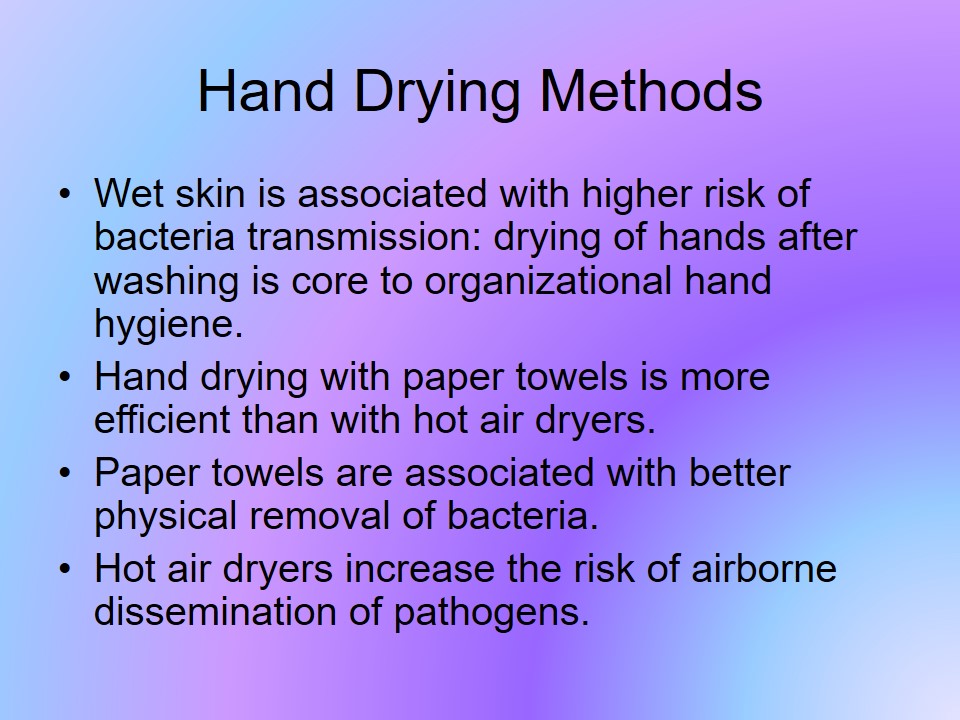
Monitoring and Audit Methods
- Monitoring is considered one of the most important tools for increasing the adherence to hand hygiene protocols in hospitals.
The universal monitoring procedure comprises the following hand hygiene moments:
- Before touching a patient,
- Before a clean or aseptic procedure,
- After body fluid exposure,
- After touching a patient,
- After touching a patient’s surroundings.
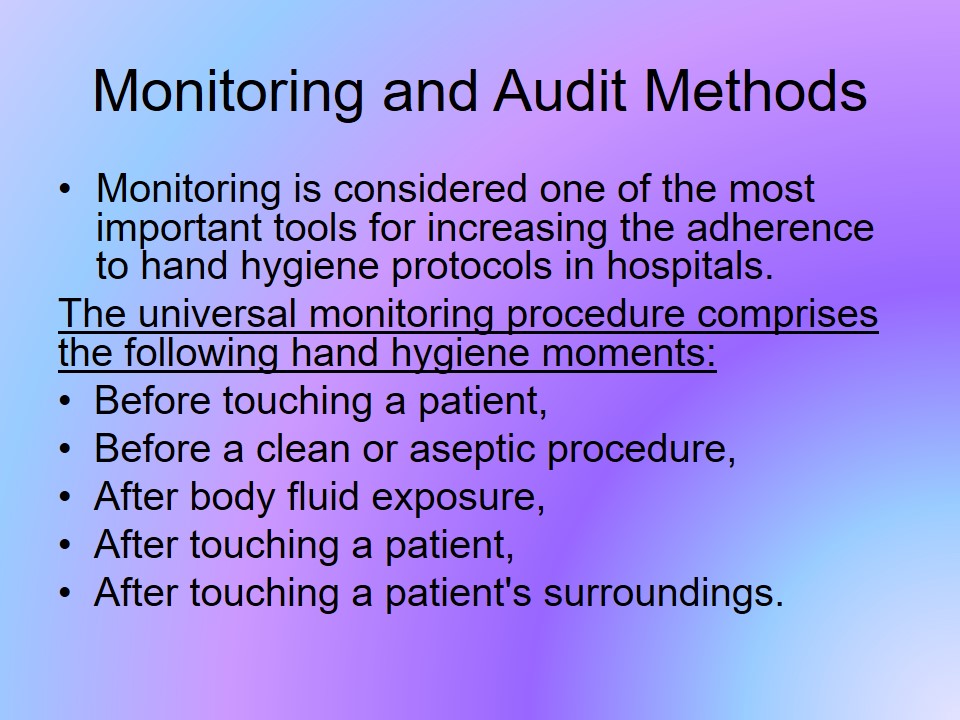
Live Observation Results
- Observed examples of compliance with safety standards:
- Hand washing prior gloving,
- Weekly change of syringe,
- Utilization of hand sanitizer,
- Easy access to equipment (gloves).
- Noncompliance examples:
- One of the nurses did not perform hand washing as per the organizational hand hygiene manual and did not change gloves regularly.
- Ambu bag was not stored properly in two observation sessions.
- Conclusion:
- The level of nurses’ compliance with the hospital policy is not sufficient.
- Workload:
- 5 to 6 patients per practitioner.
Overt observation technique was used to collect the data during the field project. The data was gathered during three sessions and the total sample comprised three nurses and three patients. Two of the nurses demonstrated proper hand hygiene: participant 1 regularly applied hand rubs before administration of medication and between gloving, and participant 3 also washed hands. However, participant 2 did not follow hand hygiene standards during medication administration (e.g., did not use hand sanitizer, change gloves frequently, etc.).
The utilization and sterilization of equipment were not consistent with safety standards at all times as well. For instance, participants 2 and 3 did not store Ambu bag over the bed not stored properly in a plastic bag, and participant 2 did not check for residual before giving the medications via the gastrostomy tube.
Overall, no hand hygiene standard in nurses’ behaviors was observed. However, participant 1 stated that he trains practitioners properly and provides all the necessary information to them yet nurses modify their hand hygiene behaviors after they start to work independently.
Since work design factors can largely define the level of compliance with standards, participants’ workloads were identified: they had a moderate workload of 5 to 6 patients per shift.
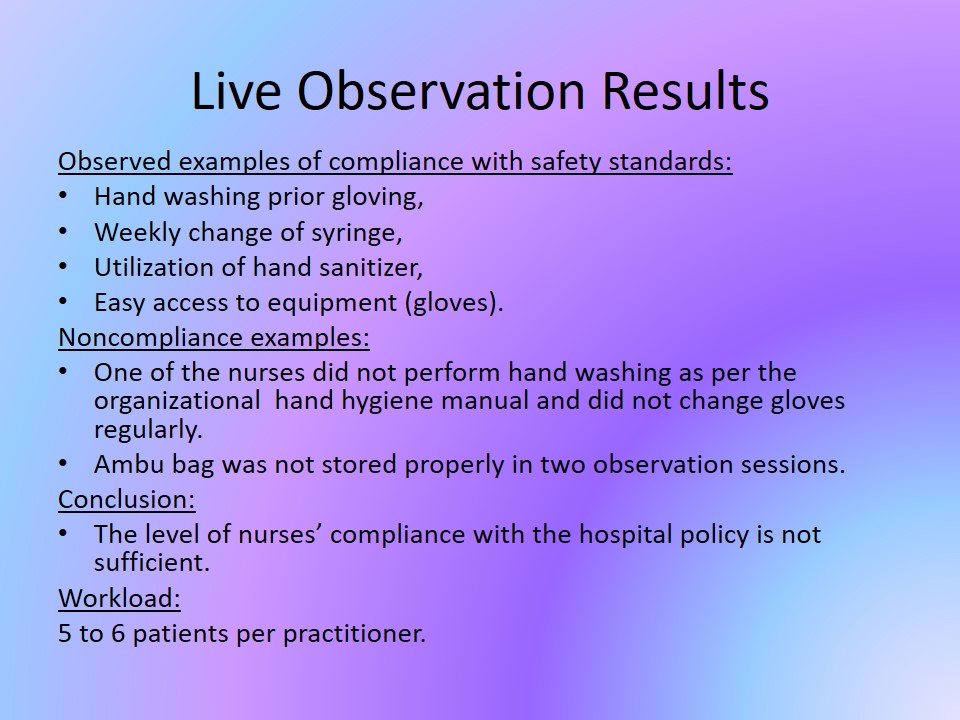
Evidence on the Existing Hand Hygiene Policies and Practices
- The existing hand hygiene policy and practices substantially reflect the reviewed evidence provided in the WHO and CDC guidelines.
- For instance, it includes some of the following recommendations (WHO, 2009, p. 58).
Although research participants did not show consistent favorable hand hygiene behaviors, they are provided with hand hygiene policy and guidelines, which substantially reflect the reviewed evidence. For instance, the indications for hand washing and use of alcohol-based hand rubs are directly retrieved from the WHO and CDC guidelines. For instance, WHO (2009) suggests performing hand hygiene “before handling medication or preparing food to perform hand hygiene using an alcohol-based hand rub or wash hands with either plain or antimicrobial soap and water,” after removing gloves, before and after touching the patient, and so on (p. 152). The organizational manual also covers a wide range of hand hygiene issues in accordance with the located evidence and national standards, e.g., the use and change of gloves after caring for a patient, nail and skin care requirements, hand preparation steps and duration of procedures, etc.
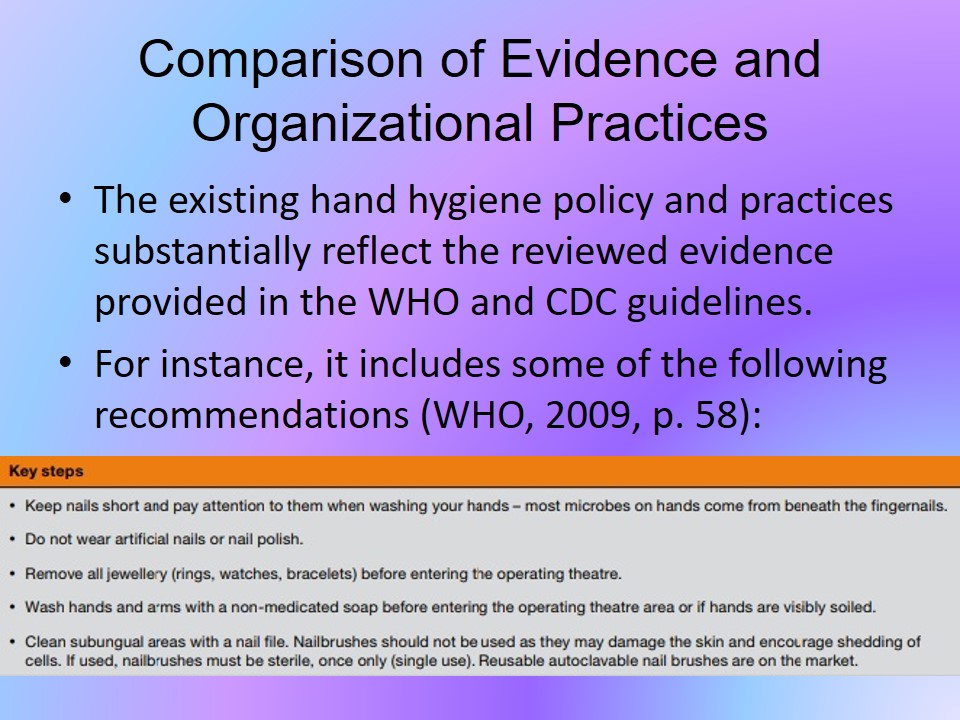
Hand Hygiene Practices and Policy Improvement
- The hospital policy lacks
- Education program requirements,
- Administrative requirements (e.g., funding, leadership strategies, etc.),
- Precise compliance monitoring indications.
- The equipment cleansing requirements list could be more elaborate as well.
- Recommendations:
- Improve equipment cleansing requirements,
- Clarify procedural sequence,
- Improve application,
- Develop detailed guidelines for setting the standard for medication administration,
- Include administrative requirements and compliance monitoring standards to increase the compliance rate.
Nevertheless, the policy does not address the education program requirements, administrative requirements, as well as compliance monitoring issues, which could help to organize the identified hand hygiene practice deficiencies in the hospital. The inclusion of these sections in the document may ensure a more standardized approach to staff training, hand hygiene audit, and promotion of protocol compliance through comprehensive strategies. Additionally, it is possible to say that the section listing the equipment cleansing requirements could be more elaborated as the national guidelines provide more profound recommendations regarding this issue than the organizational manual.
Other policy improvement recommendations developed based on the obtained observation data may be as follows:
- Clarification of sequence for gloving: remove gloves after each medication procedure- perform hand hygiene (wash hands) – replace gloves before proceeding to a next procedure with the same patient.
- Develop detailed guidelines for a standard for medication administration: include such steps as daily disinfection of medication cart; utilization of hand sanitizers before/during the preparation of meds; proper storage of drugs, syringes, and other equipment.
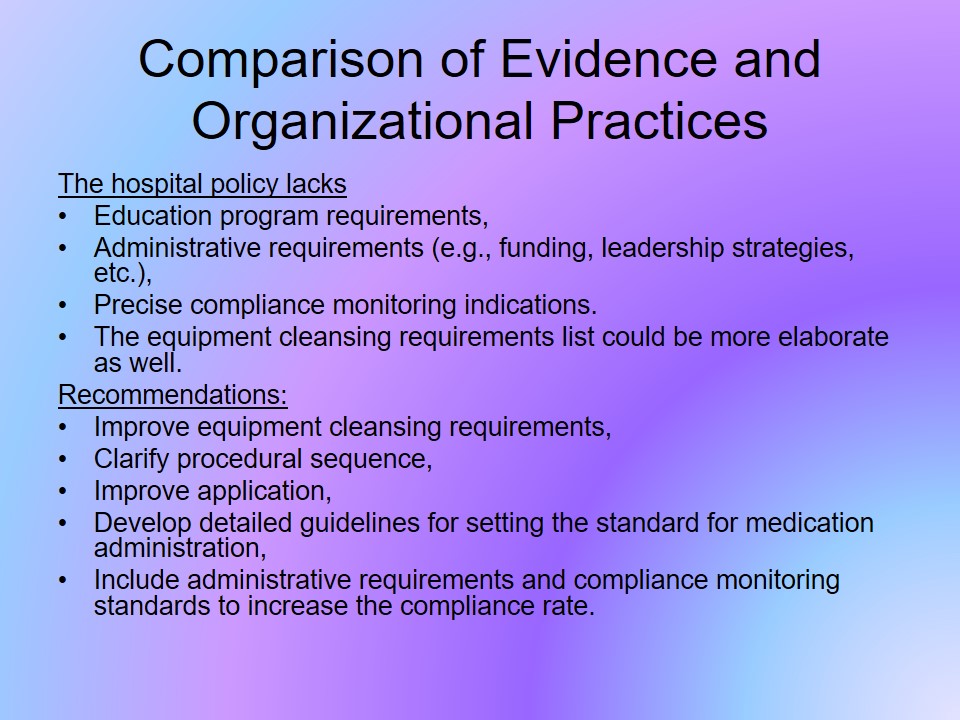
Nurse’s Role
- Social element of professional practice can largely support the adherence to safety protocols among nurses.
- The nurse can contribute to positive change by serving as a good role model.
- RN can implement coaching strategies that comprise such training activities as role play and use of scenarios.
The evidence in the located literature indicates that social element of professional practice can largely support the adherence to safety protocols among nurses. For instance, the systematic review by Winship and McClunie-Trust (2016) revealed that when practitioners are criticized for non-compliance by their colleagues, they tend to modify their behaviors and perform better. The element of knowledge plays a crucial role in nurses’ behaviors as well: when a nurse observes bad practice and also has insufficient knowledge of hand hygiene protocols, it negatively affects the overall compliance results as he/she may imitate inappropriate practices (Winship & McClunie-Trust, 2016). It means that the nurse can contribute to positive change by serving as a good role model and engaging in education regarding hand hygiene. It is possible to combine role modeling with some elements of preceptorship and praxis, i.e., role play and use of scenarios, which will help increase less experienced nurses’ self-efficacy in hand hygiene practice and promote the values of patient safety culture among them.
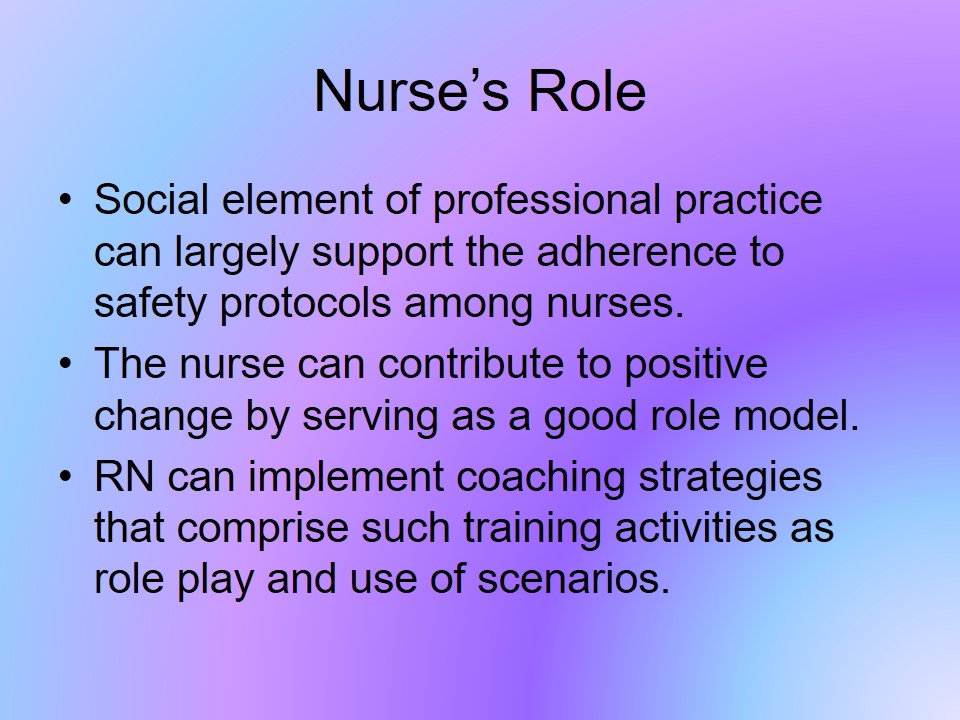
References
Centers for Disease Control and Prevention. (2001). Recommendations for preventing transmission of infections among chronic hemodialysis patients. Web.
Centers for Disease Control and Prevention. (2002). Guideline for hand hygiene in health-care settings: Recommendations of the Healthcare Infection Control Practices Advisory Committee and the HICPAC/SHEA/APIC/IDSA Hand Hygiene Task Force. Morbidity and Mortality Weekly Report,51, 1-45.
Gibson, B. E. & Markovic, D. (2015). A systematic review: Immediate and maintenance effects of interventions on handwashing compliance in healthcare workers. Web.
Huang, C., Ma, W., & Stack, S. (2012). The hygienic efficacy of different hand-drying methods: A review of the evidence. Mayo Clinic Proceedings,87(8), 791-798.
Musuuza, J. S., Barker, A., Ngam, C., Vellardita, L., & Safdar, N. (2016). Assessment of fidelity in interventions to improve hand hygiene of healthcare workers: A systematic review. Infection Control & Hospital Epidemiology,37(05), 567-575.
Winship, S., & McClunie-Trust, P. (2016). Factors influencing hand hygiene compliance among nurses: An integrative review. Kai Tiaki Nursing Research,7(1), 19-26.
World Health Organization. (2009). WHO guidelines on hand hygiene in health care. Web.